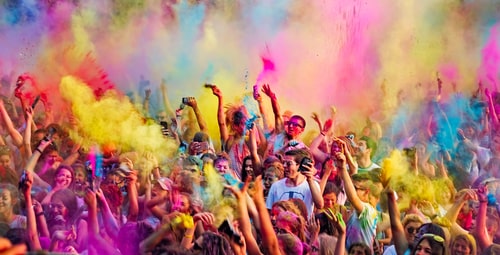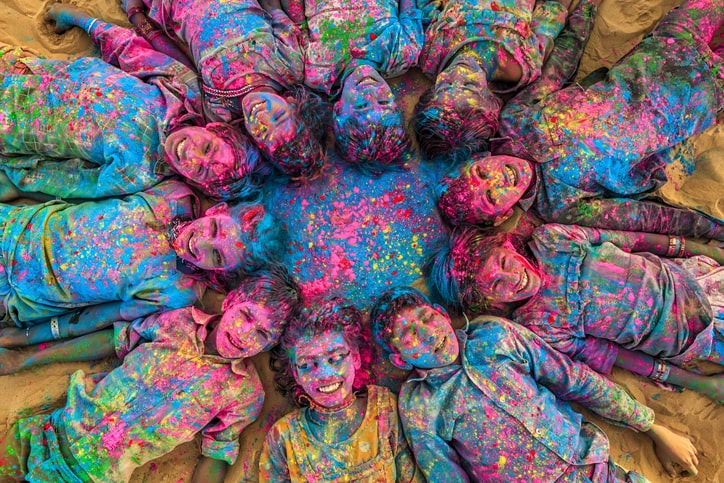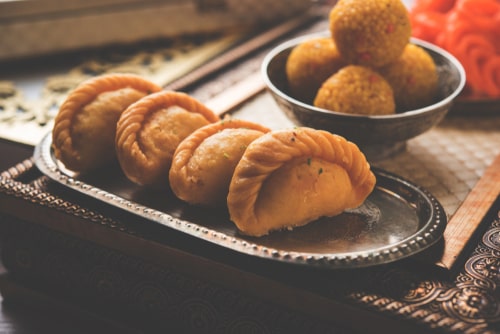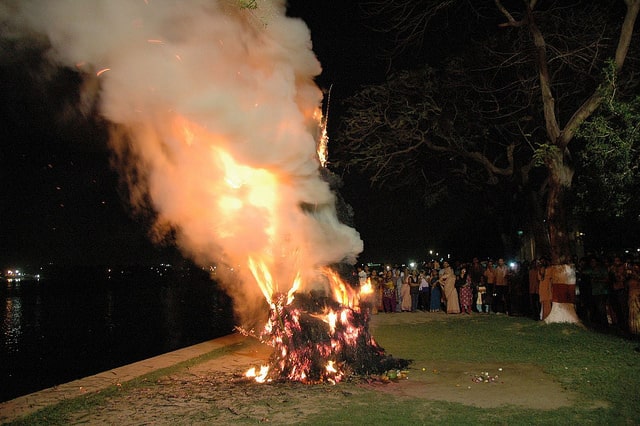Last updated on March 7th, 2023
Holi, also known as the festival of colors, is a Hindu spring festival which is celebrated in India and Nepal. In 2022, Holika Dahan was on 17th March and Rangwali Holi was celebrated on 18th March. In 2023, Holika Dahan is on 7th March and Rangwali Holi is on 8th March.
Below are some interesting facts about Holi that will help you learn more about this festival which is celebrated by millions of people from various cultures and regions. Holi is awaited eagerly even in the United States and Germany.
The festival is all about people coming together and getting rid of their worries and spending a day or two with their friends and family.
Facts about the history of Holi
1. The name Holi comes from “Holika”, the sister of demon King “Hiranyakashyap” (refer: Hindu mythology).

2. Legend has that the evil king – Hiranyakashyap – forbade his son Prahlad from worshiping one of the Hindu gods – Lord Vishnu. However, Prahlad worshiped Vishnu despite his father’s denial.
Thus the demon king ordered Prahlad to sit on pyre (a structure, usually made of wood, for burning a body as part of a funeral rite or execution) along with Holika (who was immune to fire) the sister of the demon king. When the fire started, Holika was burnt to death in spite of her immunity to fire, and miraculously Prahlad was saved because Prahlad asked the help of Lord Vishnu during the event.
The burning of Holika is celebrated as Holi. However there are other arguments as well, that support the celebration of Holi and its origin. The story is also narrated in various ways but the conclusion remains the same i.e. – “victory of good over evil.”
3. Other legend behind the origin of Holi is that Lord Krishna as a baby was poisoned by the breast milk of Putana and thus he developed the characteristic blue color of his skin. Krishna was not sure if fair skinned Radha and other girls would like him. Thus he approached Radha and colored her face in some colors. Radha accepted Krishna despite the blue color of his skin and since that day the festival of Holi is celebrated.

The occurrence of Holi and its celebration
4. Occurrence: It is celebrated after the full moon in the month of ‘Phalguna’ which generally falls between February and March.
5. The exact date of the festival is determined by the Hindu Calendar and its arrival varies on the Gregorian calendar.
6. The festival of Holi is celebrated for at least 16 days in the Brag region of India where Krishna was born.
7. Holi is also celebrated in Mauritius, Fiji, Guyana, Trinidad and Tobago, Pakistan, and the Philippines.

8. The first day is known as Holika Dahan or Chhoti Holi and the second as Rangwali Holi, Dhuleti, Dhulandi or Dhulivandan.
Facts about rituals during Holi
9. The festival of Holi is predominantly a festival of fun. People spend a lot of their time during the festival days engaging in fun activities.
10. Kids start using water balloon and water pistols a week or 10 days before Holi. They hide and target the by-passers with balloons filled with colored water and water pistols.

11. A special delight that people make at their home is Gujiya. It is a stuffed sweet delicacy where the stuffing consists of dry fruits and other sweet items. It is very popular and people enjoy the delight to their full extent.
12. A popular saying: The festival of colors is also popular for a saying “Bura na mano, Holi hai!” which means “do not mind, it’s Holi.”
13. Synthetic vs natural colors: The use of synthetic colors during the festival of Holi is a concern for some people. However, many prefer playing with water and some homemade natural colors. Natural colors are derived from indigo, sunflower, and marigold flowers.
14. It is a national festival in India and people from all the states celebrate it.
15. The festival of Holi is celebrated by Hindus all over the world. People of Nepali origin also celebrate it in different parts of the world. With every passing year, the festival is being welcomed across the world in many forms and people find great relief and satisfaction celebrating it with their friends and family.
16. The festival starts on the night before Holi when people gather and start a bonfire. The bonfire is lit up between 8 pm and midnight. People gather around the fire to watch it while eating their favorite food items, and talk with friends.

17. The Holika bonfire is a place where people gather and do their religious rituals. People during their religious rituals ask for forgiveness from the god and pray that their evil should come to an end.
18. The second day of the festival of Holi which is also referred as “Rangwali Holi” is the main day when people play with wet and dry colors. People chase each other in an attempt to color one another.
How people connect and interact during the festival?

19. Water is a big part of the event as many people use water balloons and engage in interesting water fights with their family and friends. A lot of different colors are involved and it’s a great time for everyone as every one irrespective of their age participates.
20. People generally tend to gather and celebrate this festival in open as it provides a suitable environment for the use of colors and water.
21. Sweets, food and drinks are also shared during the festival.
22. Beware of this drink: Holi is also popular for the consumption of an intoxicating article – Bhang. This ingredient is mixed into drinks and sweets and is largely consumed by many during the festival. Bhang is made from cannabis leaves.
23. Holi is a festival of fun and colors for children. Children of all age groups gather and celebrate the festival with oneness and vigor. They throw dry colors and wet colored liquids on each other and family member.

The significance of the festival
24. The delightful festival of Holi signifies the victory of good over evil. It also marks the end of winter season and welcomes the spring.
25. Good for bonding: The festival of Holi, like Diwali, is a significant one in India and Nepal. It is a great occasion for people from different religious communities, castes, colors and creeds to come together and strengthen their bonds, and also repair their broken relationships.
. . . continue reading on the next page
